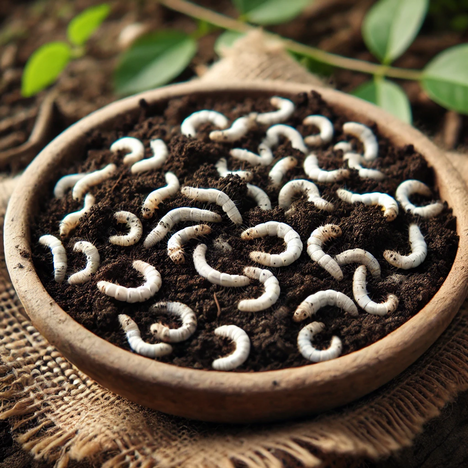Silk spinner

What is a silk moth?
The silkworm moth (Bombyx mori) is a domesticated species of butterfly that is bred primarily for the production of silk. The larvae of the silkworm moth, often referred to as silkworms, feed exclusively on mulberry leaves and go through several stages of development before spinning themselves into cocoons from which the silk is later obtained. Silk moths are not equipped to survive in the wild and exist almost exclusively in breeding facilities.
Benefits of silkworms as a snack for dogs
High protein diet
Silkworm larvae are an excellent source of protein, which is essential for muscle development and maintenance in dogs. Protein is also important for the immune system and many other bodily functions.
Contains essential fatty acids
The larvae contain essential fatty acids that can contribute to the health of the skin and coat. These fatty acids also play a role in supporting cognitive function and general health.
Vitamins and minerals
Silkworm larvae offer a variety of vitamins and minerals that can contribute to a dog's overall health, including B vitamins, calcium and iron.
Disadvantages and possible risks
Allergic reactions
As with any new protein source, there is a risk of allergic reactions. Some dogs may be sensitive to the proteins in silkworm, which can lead to skin irritation, digestive upset or other allergic symptoms.
Difficult procurement and quality assurance
Finding high-quality silkworm larvae suitable for consumption can be a challenge. It is important to ensure that the larvae are free from contaminants and have been reared in safe conditions.
Overfeeding
As with any treat, silkworm larvae should only be fed in moderation. Overfeeding can lead to weight gain and other health problems, especially if it interferes with the dog's balanced diet.
To be enjoyed with caution
Silkworm larvae can be an interesting and nutritious addition to your dog's diet, particularly due to their high protein content and essential nutrients. However, as with any dietary change, it is crucial to introduce small amounts at first and observe your dog's reaction. It is also important to ensure the quality and safety of the silkworm larvae to avoid any health risks. With the right approach, silkworm larvae could be a tasty and healthy addition to your dog's diet.
If you notice any signs of hypersensitivity or poisoning in your dog, you should see your vet immediately. We are not a substitute for a vet, but we try to be as accurate as possible. Every dog reacts differently and we recommend you get a second opinion or consult your vet if in doubt.
Stay healthy and take good care of your four-legged friend!😊